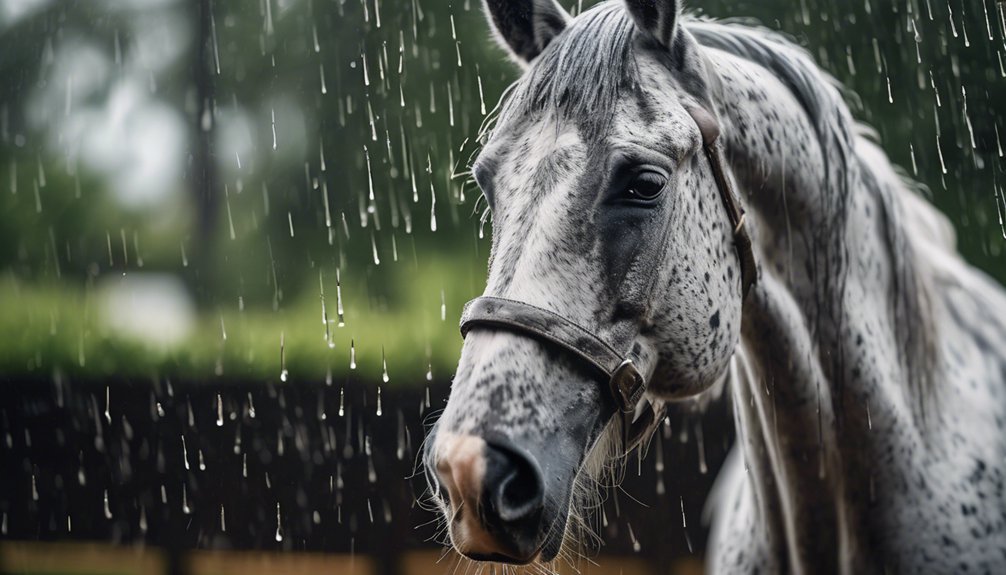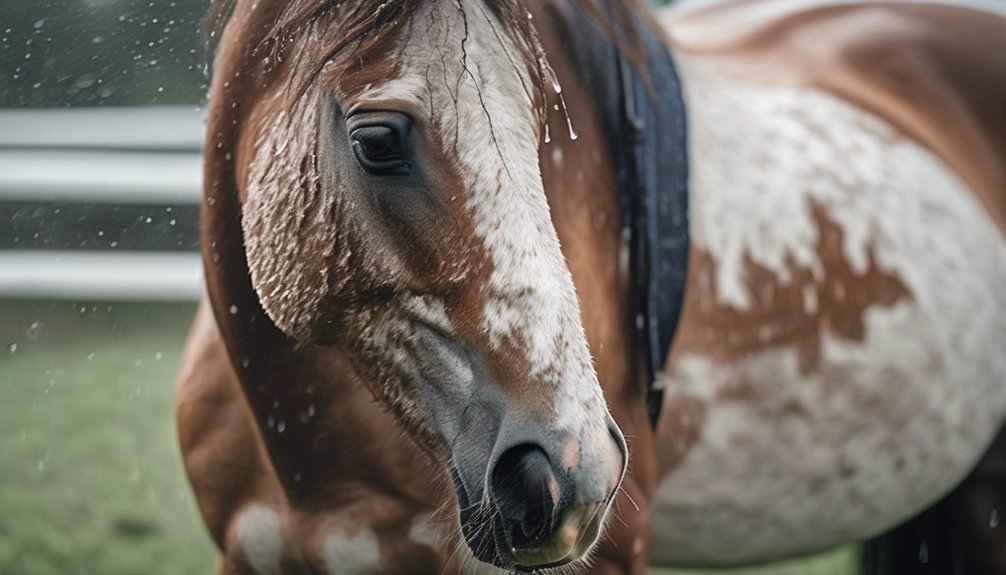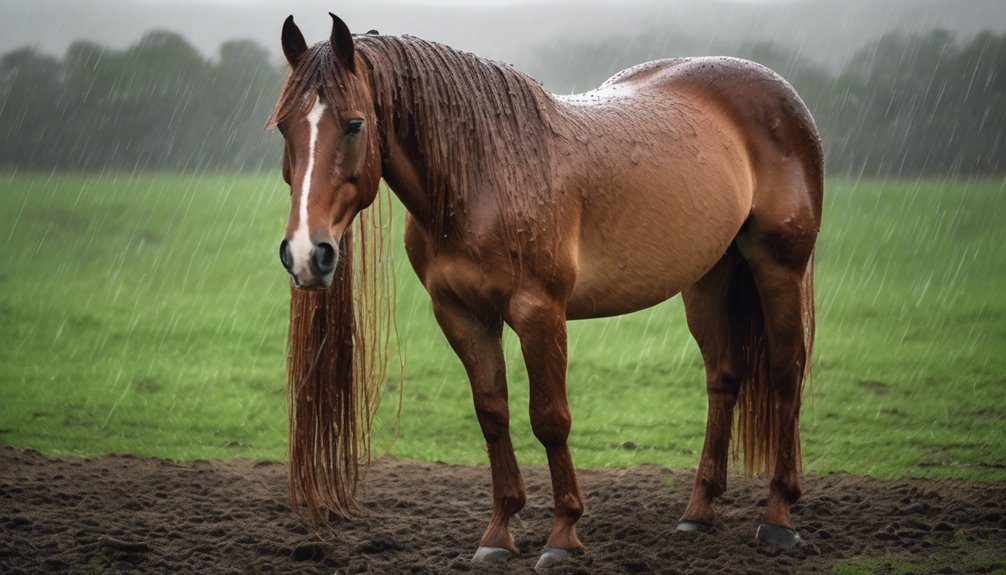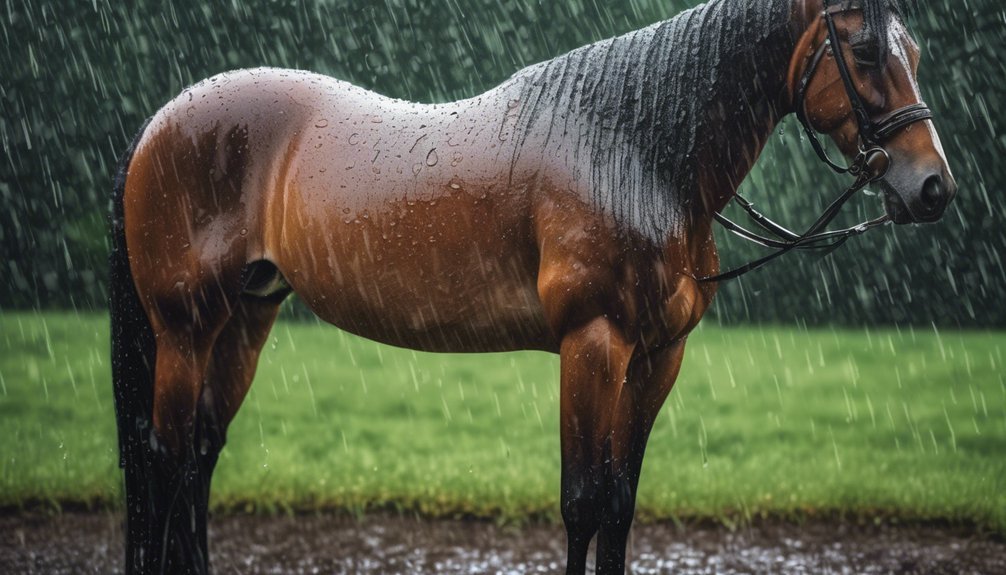
You might find it coincidental that the rainy season often leads to more than just soggy trails; it can seriously impact your horse's coat health. Maintaining a shiny, resilient coat during this time requires a strategic approach. From grooming techniques to dietary adjustments, there are several factors to consider that can make a significant difference. Understanding these elements is crucial for ensuring your horse's coat remains in peak condition despite the downpours.
Key Takeaways
- Regularly groom your horse to remove debris and distribute natural oils, preventing skin irritations during wet weather.
- Use waterproof blankets to protect your horse's coat from prolonged moisture exposure and keep them dry.
- Adjust the horse's diet to include omega-3 and omega-6 fatty acids for improved coat quality during rainy seasons.
- Designate dry areas in the paddock and implement mud management strategies to minimize mud accumulation on the coat.
- Inspect for skin irritations and parasites frequently, as wet conditions can exacerbate these issues.
Understand the Importance of Coat Care in Wet Weather

When you understand the importance of coat care in wet weather, you can significantly enhance your horse's wellbeing.
Moisture from rain can adversely affect coat health, leading to issues like fungal infections and skin irritations. Wet coats trap moisture against the skin, disrupting the natural oils essential for protection.
To mitigate these weather effects, ensure your horse has a clean, dry shelter to retreat to during storms. Regular grooming is crucial; it helps distribute oils evenly and removes debris that can cause irritation.
Additionally, consider using waterproof blankets to protect your horse's coat from prolonged exposure.
Invest in Quality Grooming Tools
Investing in quality grooming tools is essential for maintaining your horse's coat health and overall hygiene. The right tools can enhance your grooming techniques, making the process more effective and enjoyable for both you and your horse. When selecting tools, consider their durability, ease of use, and the specific needs of your horse's coat.
| Tool Type | Purpose | Recommended Brands |
|---|---|---|
| Curry Comb | Loosens dirt and hair | Oster, Wahl |
| Dandy Brush | Removes debris and dust | Shires, EquiRoyal |
| Mane Comb | Detangles manes and tails | Farnam, Tough-1 |
| Hoof Pick | Cleans hooves | Professional's Choice |
| Sponge | Applies coat conditioner | Absorbine, Equi-Spot |
Choose wisely, and you'll build a grooming toolkit that keeps your horse looking its best!
Establish a Regular Grooming Routine

A consistent grooming routine is crucial for your horse's coat health and overall well-being. By establishing this habit, you can effectively combat the challenges posed by rainy seasons.
Incorporate these grooming techniques to maintain a healthy coat:
- Daily Brushing: Use a curry comb followed by a body brush to remove dirt and mud, promoting circulation and distributing natural oils.
- Seasonal Adjustments: Tailor your grooming frequency and tools based on weather conditions; for instance, opt for waterproof brushes during wet months.
- Regular Inspections: Check for skin irritations or parasites during grooming sessions, ensuring timely intervention if needed.
Change Your Horse's Diet for Optimal Coat Health
To ensure your horse's coat remains vibrant and healthy, it's essential to adjust their diet according to their specific nutritional needs.
During rainy seasons, dietary adjustments can significantly impact coat quality. Focus on incorporating high-quality hay and grains rich in omega-3 and omega-6 fatty acids, which promote a shiny coat.
You might also consider adding nutritional supplements, such as biotin and zinc, to support skin and coat health. These supplements help improve coat texture and resilience against the elements.
Regularly assess your horse's body condition and coat appearance, adapting their feed as necessary.
Protect Against Mud and Moisture

Mud and moisture can severely impact your horse's coat health, leading to skin issues and dull fur.
To effectively protect your horse, implement these strategies for mud management and moisture barriers:
- Use a waterproof blanket: Invest in a high-quality blanket that offers protection against moisture while allowing breathability to prevent overheating.
- Create dry areas: Designate specific areas in the paddock where your horse can stay dry. Use gravel or rubber mats to minimize mud accumulation.
- Regular grooming: Brush your horse frequently to remove mud and debris, ensuring the coat remains clean and healthy.
Monitor for Skin Issues and Fungal Infections
While regular grooming and proper care are essential, you must also keep an eye out for skin issues and fungal infections that can arise due to environmental factors or neglect.
Maintaining your horse's skin health is crucial, especially during rainy seasons when moisture levels increase. Inspect your horse for signs of skin irritation, such as redness, swelling, or unusual itchiness.
Fungal infections like rain rot can develop quickly, so early detection is vital. Ensure your horse's coat is clean and dry, and avoid overcrowded, damp stabling conditions.
Implementing fungal prevention strategies, such as applying antifungal powders or sprays when needed, can significantly reduce the risk.
Use Coat Conditioners and Supplements

After addressing potential skin issues and fungal infections, enhancing your horse's coat with conditioners and supplements becomes a key aspect of coat care.
Effective coat conditioning not only improves appearance but also promotes overall health. Here's how you can incorporate conditioners and nutritional supplements into your routine:
- Conditioning Oils: Use high-quality oils that penetrate the coat, adding moisture and shine while reducing breakage.
- Protein-Rich Supplements: Consider supplements containing biotin and amino acids, essential for strengthening hair follicles and enhancing coat texture.
- Omega Fatty Acids: These are crucial for maintaining a healthy skin barrier, promoting hydration and luster.
Provide Shelter and Drying Areas for Your Horse
Providing adequate shelter and drying areas for your horse is essential for maintaining a healthy coat and skin.
Explore various shelter options, such as run-in sheds or barns, which protect your horse from the elements while allowing for air circulation. Ensure these spaces are clean and dry to prevent skin issues.
After a rainy outing, utilize effective drying techniques like using a wicking blanket or a high-absorbency towel to remove excess moisture. If conditions allow, consider letting your horse stand in a warm, sunny area to facilitate natural drying.
Regularly check your horse's coat for dampness, and promptly provide shelter to promote optimal coat health during rainy seasons.
A well-cared-for horse is a happy horse, and their coat will reflect that love.
Frequently Asked Questions
How Often Should I Groom My Horse During Rainy Seasons?
You should groom your horse daily during rainy seasons to remove mud and debris. Use effective grooming techniques and consider coat protection products to maintain cleanliness and health, ensuring your horse stays comfortable and looking great.
Are There Specific Supplements for Shiny Coats in Wet Weather?
For shiny coats in wet weather, consider supplements rich in omega fatty acids and biotin. These nutrient sources enhance coat conditioning, helping your horse maintain a healthy shine despite the challenges of damp conditions.
Can I Use Human Shampoos on My Horse?
Using human shampoos on your horse isn't recommended. Instead, consider horse shampoo alternatives specifically designed for equine coat care. These products ensure proper pH balance and support your horse's coat health better than human shampoos can.
What Signs Indicate a Fungal Infection in My Horse's Coat?
Like storm clouds gathering, signs of a fungal infection include patchy hair loss, redness, and itching. Regular coat examinations and fungal prevention measures help you catch these issues early, ensuring your horse stays healthy and comfortable.
How Can I Tell if My Horse Is Getting Enough Nutrients for Coat Health?
To assess your horse's coat condition, observe its shine and texture. Nutrient deficiencies often manifest as dullness or roughness. Regularly evaluate diet quality, ensuring it includes essential vitamins and minerals for optimal coat health.
Conclusion
Maintaining your horse's coat during rainy seasons is crucial for its overall health and appearance. By investing in quality grooming tools, establishing a consistent grooming routine, and adjusting their diet, you can ensure a resilient, glossy coat that stands up to the elements. Picture your horse emerging from the rain, its coat gleaming with vitality, free from mud and irritation. With proper care and attention, you can protect your horse's coat, keeping it beautiful and healthy throughout the wet months.





